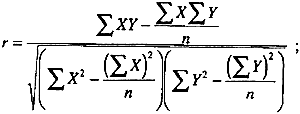GAS CHROMATOGRAPHIC ANALYSIS OF AMINO ACIDS AS ETHYL CHLOROFORMATE DERIVATIVES.MICHAEL R. SCHILLING, & HERANT P. KHANJIAN
APPENDIX1 APPENDIX 11.1 AMINO ACIDS THAT MAY BE FOUND IN ACID HYDROLYSATES OF PROTEINS
2 APPENDIX 22.1 CORRELATION COEFFICIENTSA useful statistical tool for determining the degree of association between data sets is the correlation coefficient (Anderson 1987). It is defined by the following equation:
Sinkai and Sugisita (1990) used correlation coefficients to identify proteins in adhesives, by comparing concentration data for adhesives samples to data for proteinaceous reference materials and materials that contain amino acids, such as rice starch, glue casein, egg yolk, and gelatin. The method was quite successful and provided an easy means for comparing large data sets. 3 APPENDIX 33.1 AMINO ACID COMPOSITION DATA FOR VARIOUS PROTEINS
4 APPENDIX 44.1 STABLE AMINO ACID COMPOSITION DATA FOR VARIOUS PROTEINS
REFERENCESAnderson, R. L.1987. Practical statistics for analytical chemists. New York: Van Nostrand Reinhold. Bergquist, D.1981. Eggs. In Kirk-Othmer encyclopedia of chemical technology, 3d ed.New York: John Wiley and Sons. 8:429–45. Bidlingmeyer, B. A., S. A.Cohen, and T. L.Tarvin. 1984. Rapid analysis of amino acids using precolumn derivatization. Journal of Chromatography336:93–104. Davies, K.J.A., M. E.Delsignore, and S. W.Lin. 1987. Protein damage and degradation by oxygen radicals. Journal of Biological Chemistry262(20):9902–7. Fronek, J.1994. The Los Angeles Portrait of a Man. Paper presented at the symposium “The Petrus Christus in Renaissance Bruges,” Metropolitan Museum of Art, New York. Grzywacz, C. M.1994. Identification of proteinaceous binding media in paintings by amino acid analysis using 9-fluorenylmethyl chloroformate derivatization and reversed-phase high-performance liquid chromatography. Journal of Chromatography A676(1):177–83. Halpine, S.1992. Amino acid analysis of proteinaceous media from Cosimo Tura's The Annunciation with Saint Francis and Saint Louis of Toulouse. Studies in Conservation37:22–38. Haynes, P. A., D.Sheumack, J.Kibby, and J. W.Redmond. 1991. Amino acid analysis using derivatization with 9-fluorenylmethyl chloroformate and reversed-phase HPLC. Journal of Chromatography540:177–85. Hušek, P.1991. Rapid derivatization and gas chromatographic determination of amino acids. Journal of Chromatography552:289–99. Karpowicz, A.1981. Ageing and deterioration of proteinaceous media. Studies in Conservation26:153–60. Kay, R.1983. The painter's guide to studio methods and materials. Englewood Cliffs, N.J.: Prentice-Hall. Keck, S., and T.PetersJr.1969. Identification of protein-containing paint media by quantitative amino acid analysis. Studies in Conservation14:75–82. Nowik, W.1995. Acides amines et acides gras sur un meme chromatogramme-un autre regard sur l'analyse des liants en peinture. Studies in Conservation40:120–26. Pancella, R., and R.Bart. 1989. Identification des liants organiques dans les couches picturales par chromatographie en phase gazeuse. Zeitschrift fur Kunsttechnologie3(3):101–11. Pellett, P. L.1981. Proteins. In Kirk-Othmer encyclopedia of chemical technology, 3d ed.New York: John Wiley and Sons. 15:314–41. Pickering, M. V.1989. Ion-exchange chromatography of free amino acids. LC/GC7(6):484–90. Pickering, M. V., and P.Newton. 1990. Amino acid hydrolysis: Old problems, new solutions. LC/GC8(10):778–81. Ronca, F.1994. Protein determination in polychromed stone sculptures, stuccoes and gesso grounds. Studies in Conservation39:107–20. Rothe, A.1992. Mantegna's paintings in distemper. In Andrea Mantegna, ed.J.Martineau. London: Royal Academy of Arts. 80–88. Schilling, M., H.Khanjian, and L. A. C.Souza. 1996. Gas chromatographic analysis of amino acids as ethyl chloroformate derivatives. Part 1, Composition of proteins associated with art objects and monuments. Journal of the American Institute for Conservation35:45–59.
Sinkai, T., and R.Sugisita. 1990. Identification of Souza, L.A.C.1993. Personal communication. CECOR, EBA, Universidade Federal de Minas Gerais, Belo Horizonte, MG, Brazil. Souza, L.A.C., A. R.Ramos, and C.Avila. 1992. The matriz of Catas Altas, Minas Gerais, Brazil: Techniques, materials and style. Preprints of the Contributions to the Madrid Congress, ed.H.W.M.Hodges et al. London: International Institute for Conservation of Historic and Artistic Works. 154–57. Stulik, D. C.1991. Analysis report on samples from paintings by Andrea Mantegna. Getty Conservation Institute, Marina del Rey, Calif. August 14. Stulik, D. C., E.Porta, and A.Palet. 1993. Analyses of pigments, binding media, and varnishes. In Art and Eternity: The Nefertari wall paintings conservation project 1986–92, ed.M. A.Corzo and M.Afshar. Singapore: J. Paul Getty Trust. 55–65. White, R.1984. The characterization of proteinaceous binders in art objects. National Gallery Technical Bulletin8:5–14. SUPPLIERSPigments obtained from Kremer Pigments Inc., 61 East Third St., New York, N.Y. 10003 Names and addresses of other suppliers of materials and equipment are listed in Schilling et al. 1996. AUTHOR INFORMATIONMICHAEL R. SCHILLING earned his B. S. (1983) and M.S. (1990) in chemistry from the California State Polytechnic University, Pomona. He has worked at the Getty Conservation Institute since 1983 and presently holds the position of associate scientist. His interests are thermoanalytic methods, light microscopy, gas chromatography, mass spectrometry, and color measurement. He has been active in the examination of painted museum objects, pigment identification, binding medium analysis, and analysis of volatile organic compounds in the museum environment. He has also been involved in a number of special GCI collaborative projects: conservation of the wall paintings in the tomb of Nefertari, located in Luxor, Egypt; preservation of the wall paintings and sculptures in the Dunhuang and Datong grottoes, China; and conservation of the Dead Sea scrolls in Jerusalem, Israel. Address: Getty Conservation Institute, Scientific Program, 4503 Glencoe Ave., Marina del Rey, Calif. 90292. HERANT P. KHANJIAN received his B.A. degree in chemistry from California State University, Northridge. His research interests involve the detection and identification of binding media found in art objects using gas chromatography and infrared spectroscopy. Address as for Schilling. |
